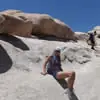How to Make a Shelter
You're in luck if you have a tarp when you get stuck in the wilderness. Simply use your paracord, or other rope, to tie it to a tree for shelter. In rain, find shelter under a "raindrop deflector," a tree with branches that extend outward and down, according to Polyczynski. He also recommends finding a snowflake catcher, where the tree branches grow upward and catch the flakes.
More: The 7 W's of Hiking Safety
Always Check the River Current
You won't always need to ford a river while hiking or camping, but when you do, it's important you do so carefully. First, find a long stick and keep two points on the ground at all times—one foot and the stick, for example. Take a shorter stick and throw it in the water. If the current is carrying it faster than you can walk, find another point to cross.
How to Tie Important Knots
This is an outdoor skill that any survivalist has memorized. A well-done knot can save you in a bind, help you cross through dangerous terrain and be useful in first aid. Outdoor Life recommends you learn how to tie most or all of the 20 essential knots—check it out on OutdoorLife.com.
How to Recognize Poisonous Plants
If you're lost, or have run out of food on a trip, plants may be your only source of sustenance. Knowing the difference between edible and poisonous plants can be the difference between surviving and not. Don't rely on memory if you're new to plant identification. Instead, always carry an edible plant book.
If you don't have one, remember one important survivalist tip: avoid all mushrooms, which are hard to identify and often poisonous.
More: How to Avoid Poisonous Plants
How to Camouflage Yourself
If you can't run away from an animal, it's important to know how to camouflage yourself. In general, remember three things: shape, texture and color. Make your shape different from that of a human by placing leaves or plants on your body—tuck them into your pockets, so they hang out, for example. Texture and color work together: use leaves, dirt and rocks to create a natural texture and blend in with the surrounding colors.
More: 10 Life or Death Survival Myths
 Book your next camping trip
Book your next camping trip



